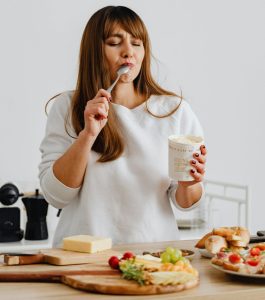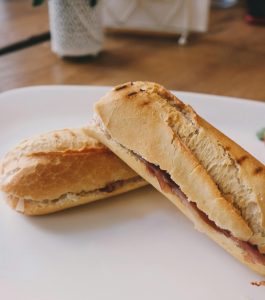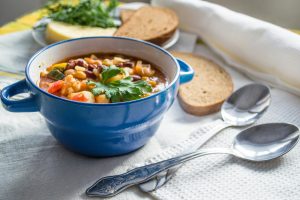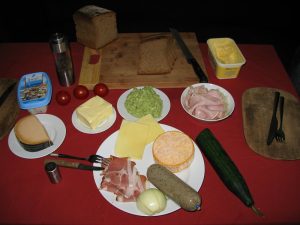6.6 Schwarzes Brot macht Wangen rot

Guten Morgen!
Zum Aufwärmen machen wir unseren Tagesminiplausch und eine Wiederholung.
Wiederholung
In the previous lesson, you learned all about Frühstück. Let’s review what you have learned.
Was isst du morgens? Was willst du essen? Sometimes those are different. Write your responses in your journal.
Lektionsüberblick
You’ve heard the phrase “to eat a hot meal” in English. In German, the times when one might eat a hot meal or a cold meal is a little different than in America. Germans often eat eine warme Mahlzeit (a warm meal) at the midday meal and eine kalte Mahlzeit (a cold meal) in the evening – the reverse order of the typical American diet. In the end, while talking about the so-called kalte Mahlzeit, you will be able to 1) talk about the frequency with which you consume some typical foods, 2) ask others about their preferences, and 3) talk about your preferences.
Was weißt du schon?
Before we start check your existing skill level with the material.
| Noch nicht start klar?
Du kannst immer auf die gleiche 1010-Lektion zurückgreifen! |
Not confident about starting this lesson?
You can always review the same Lektion from 1010. |
1) die kalte Mahlzeit
What foods might be included in die kalte Mahlzeit? Look below for some words you know, as well as new ones. Which words are similar to English? Which ones are quite different?
Let’s practice how to talk about how often you eat soup.
Jetzt bist du dran!
2) Asking about food preferences
Listen to some possible questions you might hear from someone who was interested in your food choices. How can you tell which ones are Ja/Nein questions and which ones are requesting information above and beyond a simple yes or no?
| Isst du lieber ein belegtes Brot mit Aufschnitt oder einen Salat? | ||
| Isst du lieber Kartoffel- oder Maischips? | ||
| Isst du lieber warm oder kalt zu Mittag? | ||
| Was isst du am liebsten? |
Let’s practice.
Jetzt bist du dran!
Hamburg im Blickpunkt

Die St. Michaelis Kirche (umgangssprachlich: Michel) mit ihrem 132,14 Meter hohen Kirchturm prägt die Silhouette der Stadt und galt schon früh als Orientierungsmarke für die auf der Elbe nach Hamburg segelnden Schiffe. Die Uhr im Kirchturm hat ein Durchmesser von acht Metern und ist die größte ihrer Art in Deutschland. Sie wurde 1911 in Betrieb genommen. Der große Zeiger hat eine Länge von 4,91 Metern und der kleine von 3,65 Metern. Jeder dieser Zeiger wiegt 130 Kilogramm und ist – genauso wie die umgebenden Ziffern – mit Blattgold belegt.

St. Michaelis Church (colloquially: Michel), with its 132.14-meter-high tower (433.5ft), shapes the city’s skyline and had served as a point of orientation for ships sailing up the Elbe toward Hamburg. The clock in the church tower has a diameter of eight meters and is the largest of its kind in Germany. It was put into operation in 1911. The large hand is 4.91 meters (16ft) long and the small one 3.65 meters (12ft). Each of these hands weighs 130 kilograms (286.6lbs) and—like the surrounding numerals—is covered with gold leaf.
3) Lieber und am liebsten
What are your mealtime preferences? Warm oder kalt? Salat oder Suppe? There are so many decisions each meal time. Look at some examples.
 |
 |
 |
| Ich esse lieber kalt zu Mittag. | Ich esse lieber ein belegtes Brot mit Aufschnitt als einen Salat. | Ich esse eine Gemüsesuppe mit Brot am liebsten. |
Some other examples include:
Ich esse lieber Brötchen als Brot.
Ich esse Vollkornbrot am liebsten.
Ich esse lieber ein Sandwich mit Mayonnaise als Senf.
Jetzt bist du dran!
Zum Schluß
 |

*As you conclude this lesson, don’t forget to check Canvas!*

Media Attributions
- 1020-banner-large-reduced
- pexels-karolina-grabowska-6660117
- Photo of sandwich by pexels-brigitte-tohm-36757-186861
- Photo of soup by pexels-navada-ra-628779-1703272
- Photo of Abendbrot by Gourmandise at https://www.flickr.com/photos/19027848@N00/

